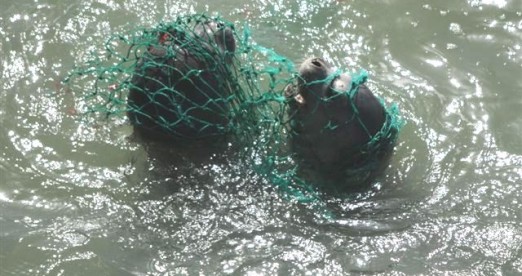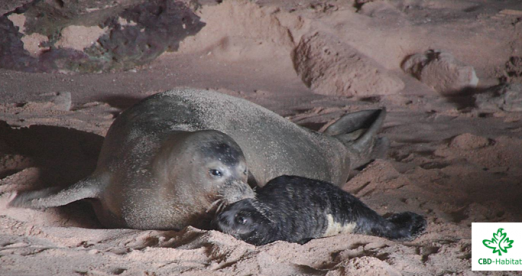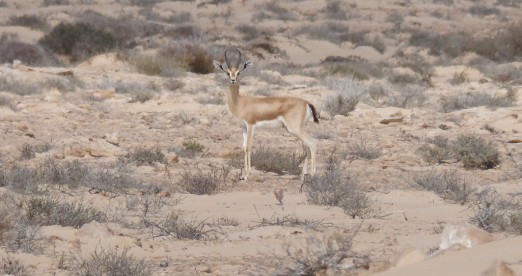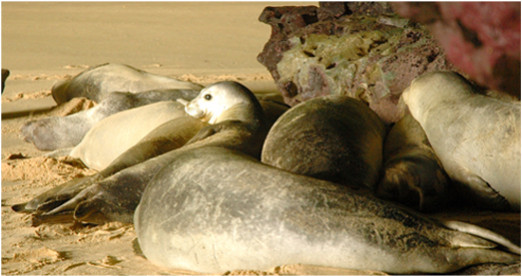When life depends on a thread
Publicado por Fundación CBD-Habitat
The history of the monk seal colony of Cabo Blanco is very related to fishery activity. Western Sahara coast represents one of the most productive fishing grounds of the world. Fisheries is one of the main economic activities in Mauritania.
Negative interaction with fishing gears has been identified as the biggest threat for the survival of the species, at the western Sahara coast and at the Mediterranean as well, during the second half of 20th century.
Between 1940 and 1989, the intense industrial fishing activity developed by international fleet on these waters originated a high decline of the monk seal population. And it was intensified at the decade of 70s with the appearance of a new capture material .
The fatidic thread that we have mentioned on the title is no other than NYLON. The monofilament nets, easy manufactured with it, have substituted the cotton ones. This material means a great danger for marine biodiversity all over the world. They are cheap, light, time persistent and very effective. Marine species cannot detect them easily and are not able to free themselves when trapped on them. If they break, fishermen prefer to assume its cost than repair them. In a lot of cases damaged fragments are thrown to the sea where they stay for many years at the bottom or adrift working as a phantom fishing and trapping other marine species, even when they emerge to beaches. Fortunately, Mauritania has banned recently its use to safeguard its fishery resources and marine biodiversity. But, regrettably, its illegal use is generalized.
One of the most effective measures to avoid interactions of seals with fishing arts is to establish protected marine areas properly guarded. On 1993 Morocco decreed the Free Fishery Zone, a polygon of 56km of coastal area and 22km offshore, with the aim of protecting the monk seals and recover fishery resources. Which has separated from shore the industrial fishing vessels. But some of the Mauritanian artisanal fishing pirogues defy the surveillance and go inside, even risking to be captured by official authorities.
To reinforce and help this surveillance, and prevent that fishing gears of those artisanal pirogues are placed near the breeding caves, we created “Costa de las Focas” reserve on 2001, of 6Km of length, with the agreement of authorities and fishermen, and following the guideline of the Action Plan for the Recovery of the Mediterranean Monk Seal in the Eastern Atlantic.
Adult seals have already learned how to avoid getting entangled on fishing gears. But juveniles are unconscious of the threat they represent and they still do not know how to dodge them. Their curiosity and willing to play could kill them easily, as we were able to confirm.
With the intention of evaluate the incidence of artisanal fishery on the Cabo Blanco colony, we have started a study of identification and catalogue of the pirogues that sneak illegally into the forbidden area. During 2014 at the mentioned total area, 56 different pirogues have been identified. Which is less than 1% of the fleet registered at NDB, that goes up to around 6.000 pirogues. And a very low incidence of the artisanal fishing activity with a higher presence of the nets on May and September.
But 6.000 nets are not needed to make young seals die trapped on them. Just only one net is enough, infringing the ban, placed in front of one of the reproductive caves, so more than one juvenile gets trapped on it.
Youngsters are the hope for the recovery of the world’s largest Mediterranean monk seal colony.
Negative interaction with fishing gears has been identified as the biggest threat for the survival of the species, at the western Sahara coast and at the Mediterranean as well, during the second half of 20th century.
Between 1940 and 1989, the intense industrial fishing activity developed by international fleet on these waters originated a high decline of the monk seal population. And it was intensified at the decade of 70s with the appearance of a new capture material .
The fatidic thread that we have mentioned on the title is no other than NYLON. The monofilament nets, easy manufactured with it, have substituted the cotton ones. This material means a great danger for marine biodiversity all over the world. They are cheap, light, time persistent and very effective. Marine species cannot detect them easily and are not able to free themselves when trapped on them. If they break, fishermen prefer to assume its cost than repair them. In a lot of cases damaged fragments are thrown to the sea where they stay for many years at the bottom or adrift working as a phantom fishing and trapping other marine species, even when they emerge to beaches. Fortunately, Mauritania has banned recently its use to safeguard its fishery resources and marine biodiversity. But, regrettably, its illegal use is generalized.
One of the most effective measures to avoid interactions of seals with fishing arts is to establish protected marine areas properly guarded. On 1993 Morocco decreed the Free Fishery Zone, a polygon of 56km of coastal area and 22km offshore, with the aim of protecting the monk seals and recover fishery resources. Which has separated from shore the industrial fishing vessels. But some of the Mauritanian artisanal fishing pirogues defy the surveillance and go inside, even risking to be captured by official authorities.
To reinforce and help this surveillance, and prevent that fishing gears of those artisanal pirogues are placed near the breeding caves, we created “Costa de las Focas” reserve on 2001, of 6Km of length, with the agreement of authorities and fishermen, and following the guideline of the Action Plan for the Recovery of the Mediterranean Monk Seal in the Eastern Atlantic.
Adult seals have already learned how to avoid getting entangled on fishing gears. But juveniles are unconscious of the threat they represent and they still do not know how to dodge them. Their curiosity and willing to play could kill them easily, as we were able to confirm.
With the intention of evaluate the incidence of artisanal fishery on the Cabo Blanco colony, we have started a study of identification and catalogue of the pirogues that sneak illegally into the forbidden area. During 2014 at the mentioned total area, 56 different pirogues have been identified. Which is less than 1% of the fleet registered at NDB, that goes up to around 6.000 pirogues. And a very low incidence of the artisanal fishing activity with a higher presence of the nets on May and September.
But 6.000 nets are not needed to make young seals die trapped on them. Just only one net is enough, infringing the ban, placed in front of one of the reproductive caves, so more than one juvenile gets trapped on it.
Youngsters are the hope for the recovery of the world’s largest Mediterranean monk seal colony.








